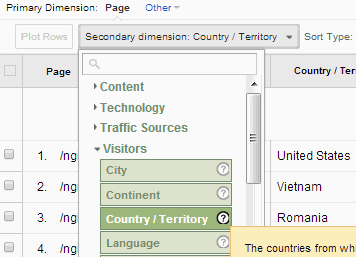Secondary Dimension in Google Analytics: Finest Practices and Tips
Transform Your Analytics Approach With Secondary Measurement in Google Analytics
By integrating additional dimensions right into data analysis, a new layer of insights emerges, dropping light on intricate individual actions and interactions. The critical application of secondary measurements holds the key to unlocking a prize chest of important information that can reinvent exactly how businesses analyze and act upon their information.
Comprehending Second Measurements in Google Analytics
Second measurements in Google Analytics supply additional context to main information by enabling customers to evaluate metrics across a second measurement, using deeper insights right into individual actions and interactions on a web site. Secondary Dimension in Google Analytics. While main dimensions provide basic information points such as pageviews, bounce price, and session period, additional measurements supply a more thorough view by segmenting the primary data further. This division permits customers to assess metrics in mix with another dimension, such as traffic resources, demographics, or customer behavior
Advantages of Using Second Dimensions
Making use of secondary dimensions in Google Analytics offers a strategic benefit by boosting the depth of evaluation and providing an extra detailed understanding of individual interactions and actions on a site. By incorporating second measurements, experts can obtain important understandings right into the performance of particular segments or variables within their data. This allows a more comprehensive evaluation of user behavior past surface-level metrics, permitting a much deeper exploration of the elements influencing customer involvement and conversions.

How to Implement Second Measurements
When integrating additional dimensions in Google Analytics, one crucial action is to choose the relevant metrics and dimensions to enrich the analysis procedure. To carry out additional dimensions effectively, beginning by accessing your Google Analytics account and navigating to the report you intend to boost with added information. As soon as in the record, locate the "Additional Measurement" button, generally found over the data table. Clicking this button will open up a drop-down menu listing different measurements that can be included in your main dimension for much deeper understandings.
After picking the suitable secondary measurement, such as 'Source/Medium' or 'Device Category,' Google Analytics will certainly present the data in a much more detailed style, permitting you to cross-analyze different elements of customer behavior. Remember to trying out different combinations of main and additional dimensions to reveal valuable patterns and patterns that can educate your marketing approaches. By executing second dimensions thoughtfully, you can get a much more comprehensive understanding of your site or app efficiency and make data-driven choices to optimize your electronic presence.
Analyzing Information With Additional Measurements
Improve your data evaluation in Google Analytics more information by integrating secondary measurements to dig deeper right into individual behavior patterns and optimize your electronic advertising and marketing methods successfully - Secondary Dimension in Google Analytics. By adding secondary measurements to your main data, you can acquire important insights that can help you make informed choices regarding your website or application efficiency
Evaluating data with second measurements enables you to segment your main data better, supplying a much more thorough view of individual communications. Incorporating the primary dimension of 'source/medium' with a second dimension like 'landing web page' can reveal which details pages are driving web traffic from different sources. This information can be crucial in refining your web content strategy or maximizing your ad campaign to enhance conversions.
In addition, using second dimensions enables you to identify connections in between different metrics, aiding you comprehend the impact of numerous factors on individual actions. Whether it's evaluating demographics along with customer involvement metrics or device categories with conversion rates, additional dimensions equip you to discover concealed fads and patterns that can lead your marketing efforts.
Optimizing Performance With Secondary Dimensions
To improve the effectiveness of data analysis and decision-making in Google Analytics, integrating additional dimensions is essential to enhancing efficiency metrics and obtaining much deeper understandings right into customer actions patterns. By utilizing secondary dimensions, analysts can delve beyond surface-level data and discover valuable connections that might or else go undetected. This optimization approach enables companies to customize their advertising and marketing initiatives more efficiently, recognize locations for improvement in site functionality, and improve general individual experience.
Additional measurements supply an even more thorough view of user interactions by giving added context to primary information metrics. Coupling the key dimension of 'touchdown page' with a second dimension like 'device classification' can expose whether particular gadgets are more most likely to drive engagement on certain landing web pages. This insight can educate responsive style improvements or targeted advertising and marketing approaches to increase efficiency.

Verdict
In conclusion, the integration of secondary dimensions in Google Analytics offers businesses with discover here an effective device to improve their analytics method. Secondary Dimension in Google Analytics. By delving deeper right into customer habits and communications, marketing experts can discover important understandings that can drive efficiency optimization and improve the total individual experience. Leveraging additional dimensions enables for a more thorough evaluation of data, leading to even more informed decision-making and customized advertising initiatives
Additional measurements in Google Analytics supply additional context to primary information by enabling customers to examine metrics across a 2nd dimension, supplying much deeper understandings into customer behavior and communications on a site. While key dimensions supply fundamental data factors such as pageviews, bounce price, and session period, additional measurements supply a more resource thorough view by segmenting the primary information better.One of the key benefits of making use of second measurements is the ability to reveal relationships and patterns that might not be immediately evident when evaluating information with primary measurements alone.When integrating additional measurements in Google Analytics, one necessary action is to select the relevant metrics and dimensions to enrich the analysis process. Matching the key measurement of 'touchdown web page' with a second dimension like 'device classification' can expose whether particular tools are more likely to drive interaction on details touchdown web pages.